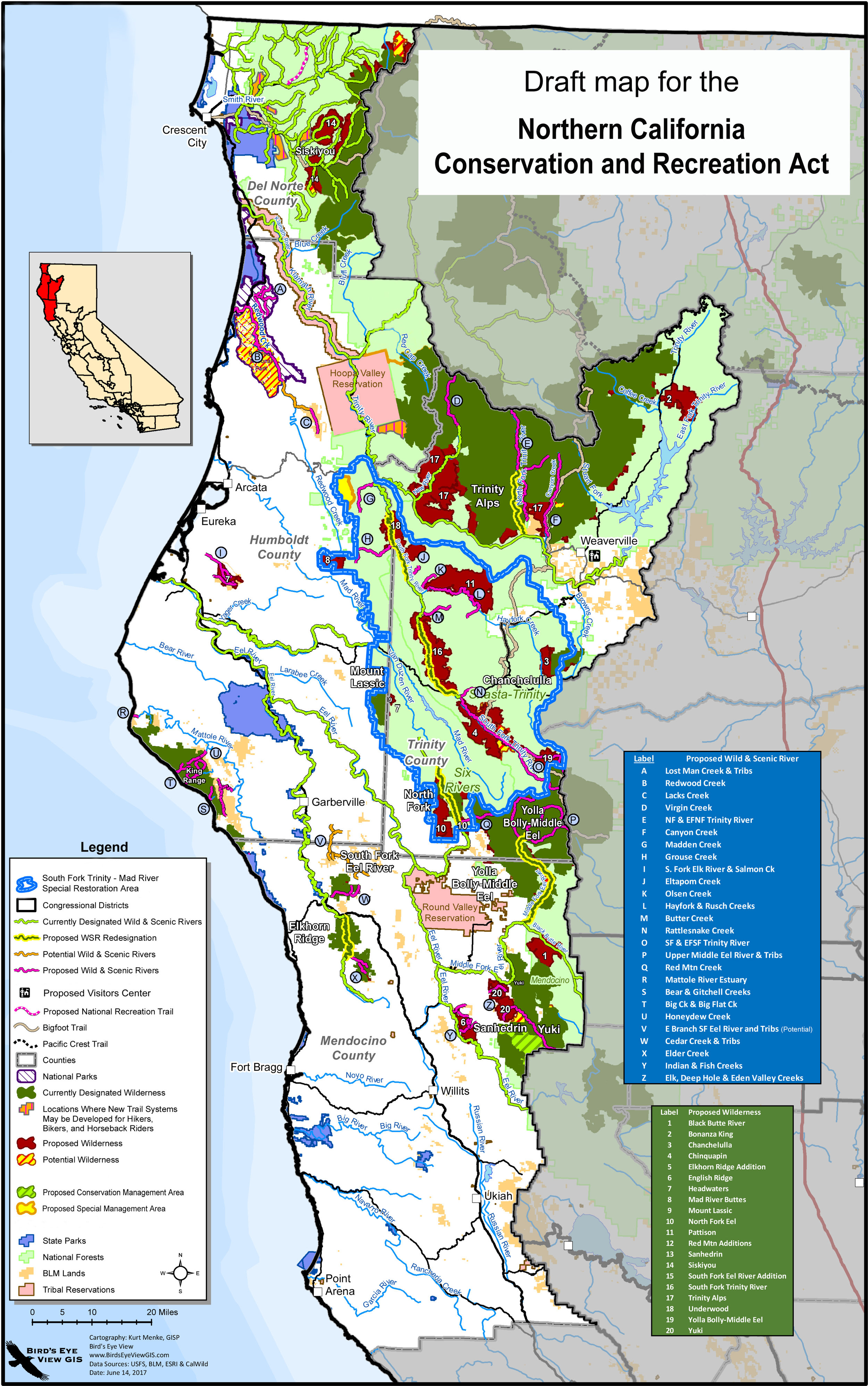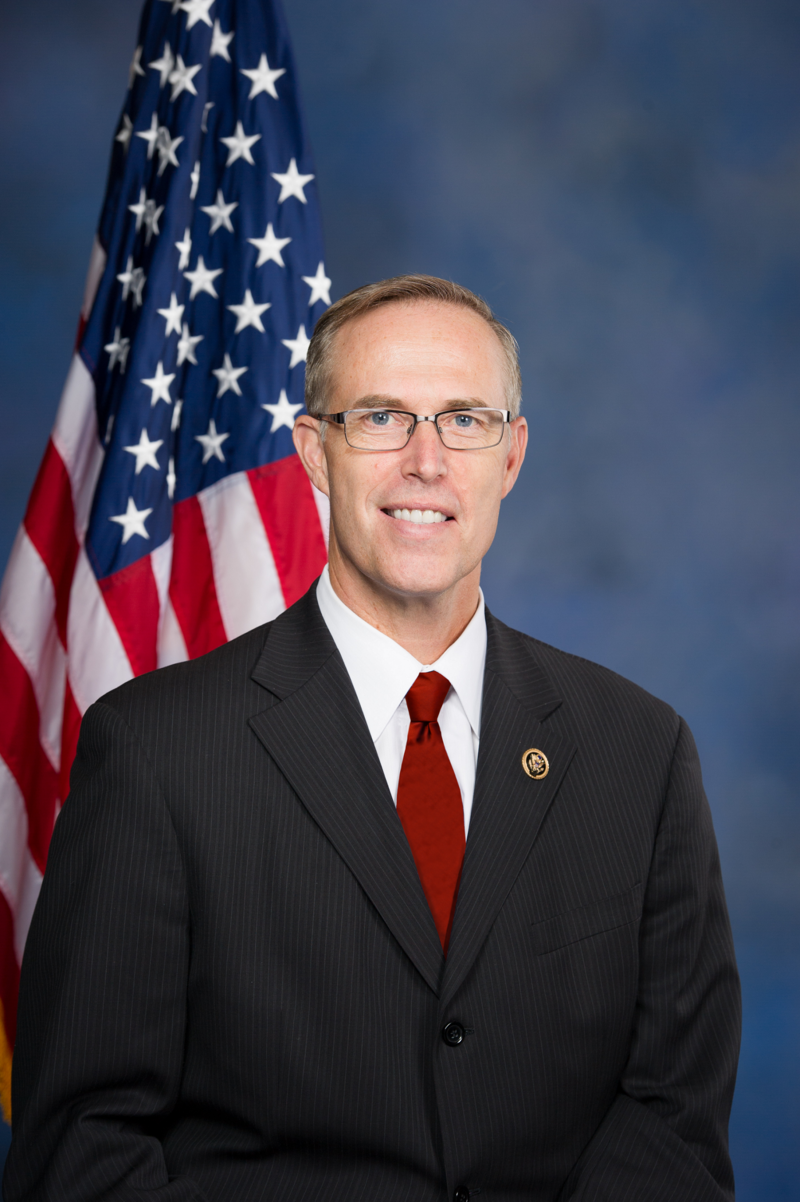Rep. Jared Huffman (D-2nd-CA) has announced his intention to introduce legislation in the U.S. House of Representatives to expand nine existing wilderness areas, establish ten new wilderness areas (326, 000 acres; the press release says ten new areas, but the draft bill only has nine), designate more than 300 miles of wild and scenic rivers, and establish additional conservation and recreation areas in his congressional district.
You can download a high-quality version from Rep. Huffman's website. Source: Rep. Jared Huffman Office.
“On the North Coast of California, we are privileged to live among some of the most stunning old-growth forests and pristine rivers in the world,” said Rep. Huffman. “But we can do more to manage these spectacular public lands to protect communities, restore forest health from illegal marijuana grows, and improve trails and recreational opportunities. I want to hear your ideas on how to protect our forests and watersheds while creating economic opportunities and safeguarding our homes. By putting our heads together, we can create collaborative solutions to protect our communities and the lands we value for generations to come.”
His very good Northern California Conservation and Recreation Act draft is available for public review. You can download the draft bill, a one-page summary, and a general map. (A slightly more accurate title would include "Northwestern" rather than "Northern" as Huffman's bill doesn't encompass any of northern California outside of his congressional district.)
In addition to the usual (and vital) proposed additions to the National Wilderness Preservation System and the National Wild and Scenic Rivers System, Huffman’s draft legislation proposes several innovative and novel congressional designations that call for ecological restoration, nature conservation, and/or increased recreation.
The Huffman bill has three major sections: (I) Restoration and Economic Development, (II) Recreation, and (III) Conservation.
Under Restoration and Economic Development, the draft bill would
· establish a South Fork Trinity–Mad River Restoration Area that would direct the Forest Service and Bureau of Land Management (BLM) to ecologically restore degraded landscapes and watersheds by using the best available science on more than 700,000 acres;
· establish a Northwest California Public Lands Remediation Partnership to address cleaning up public lands polluted by marijuana cultivation and other dangerous activities;
· establish a visitor center in Weaverville for the Whiskeytown-Shasta-Trinity National Recreation Area; and
· require the Forest Service, as it is revising land and resource management plans for the Shasta-Trinity, Six Rivers, Klamath, and Mendocino national forests, to address comprehensive fire management in wilderness lands.
Under Recreation, the draft bill would
· establish a Horse Mountain Special Management Area (the draft also calls it a “recreation area”), of a size to be determined, to “enhance the recreational and scenic values of the recreation area while conserving the plants, wildlife, and other natural resource values of the area,” where motorized vehicles would be permitted only on designated roads and trails and snowmobiles allowed under certain circumstances;
· require the Forest Service to study the feasibility of a Bigfoot National Recreational Trail, and if it is found feasible, to designate it a part of the National Trails System;
· establish an Elk Camp Ridge Recreational Trail for off-road vehicles, mountain bikes, or both;
· study improving motorized and nonmotorized recreational trail opportunities on federal public lands outside of wilderness areas on the Shasta-Trinity, Mendocino, and Six Rivers national forests; and
· study mountain biking and other nonmotorized trail use in Del Norte County.
Under Conservation, the draft bill would
· establish the Black Butte, Bonanza King, Cinquapin, English Ridge, Headwaters Forest, Mad River Buttes, Pattison, South Fork Trinity River, and Underwood wildernesses;
· expand the Chanchelulla, Mount Lassic, North Fork (and rename it the North Fork Eel River), Sanhedrin, Siskiyou, South Fork Eel River, Trinity Alps, Yolla Bolly–Middle Eel, and Yuki wildernesses;
· designate as “potential wilderness” (where the Forest Service can use mechanical equipment to ecologically restore degraded portions; in any case they automatically become wilderness within ten years of the date of enactment of the act) land in Redwood National Park and adjacent to the Siskiyou, South Fork Trinity, Trinity Alps, Yolla Bolly, and Yuki wildernesses;
· establish as wild and scenic rivers the South Fork Trinity, East Fork South Fork Trinity, Butter Creek, Hayfork Creek, Olsen Creek, Rusch Creek, Eltapom Creek, Grouse Creek, Madden Creek, Canyon Creek, North Fork Trinity River, East Fork North Fork Trinity River, New River, Middle Eel River, North Fork Eel River, Red Mountain Creek, Redwood Creek, Lacks Creek, Lost Man Creek, Little Lost Man Creek, South Fork Eel River, Salmon Creek, Elder Creek, Cedar Creek, East Branch South Fork Eel River, Mattole River Estuary, Honeydew Creek, Bear Creek, Gitchell Creek, Big Creek, Elk Creek, Eden Creek, Deep Hole Creek, Indian Creek, and Fish Creek; and
· establish a Sanhedrin Conservation Management Area.
During the August congressional recess, Huffman is taking public comment at events in Eureka, Crescent City, Weaverville, and Ukiah. Rep. Huffman is encouraging constituents to read more about this legislative proposal and send any feedback, additions, suggestions, or edits to ca02publiclands@gmail.com.
While I’m not a constituent, these are my federal public lands, so permit me here to make a few suggestions to Rep. Huffman.
Refocus the fire-industrial complex. While relatively quite innovative for congressional legislation and generally seeking a good outcome, the draft legislative language addressing ecological restoration somewhat misses the mark. The Huffman draft calls for fire management plans in wilderness but then expects the Forest Service—the center of the fire-industrial complex—to rationally conclude that letting fire burn in wilderness is ecologically beneficial and there is no need to put in harm’s way young people whose prefrontal cortexes are not fully developed. His draft bill language bans chemical use in the restoration area but gives a pass to fire retardants, which are quite dangerous. The draft language is overly reliant on fuel breaks (which don’t stop airborne embers and must be periodically maintained) and doesn’t focus on the areas of land that, if treated, will almost guarantee that a building in the wildland-urban interface will not burn—within 100 feet of that building. I commend to all the comments on the draft Huffman bill prepared by the Geos Institute.
Include a voluntary retirement provision for federal grazing permits and leases. The various special management areas in the draft bill would condition livestock grazing in ways compatible with the purposes of the area. Practically, such grazing will be difficult to attain or sustain, so the bill should include a provision that requires the land management agencies to not reissue grazing permits or leases if the permittee or lessee waives them back to the federal government. This would allow third-party money to be used to compensate permit and lease holders for doing so. In 2012, Senator Feinstein (D-CA) persuaded Congress to do this for grazing in the California Desert Conservation Area and Congress has done the same in several other areas.
Expand the Siskiyou Wilderness to include all roadless land in the East Fork Illinois River watershed. Inexplicably, the draft boundary for the expansion of the wilderness doesn’t include the lower portions of the watershed. The lands are as roadless and worthy as any.
Establish the East Fork Illinois Wild and Scenic River. The East Fork and its tributaries are worthy of inclusion in the National Wild and Scenic Rivers System. (While most of the Illinois River watershed is in Oregon, the headwaters of both the east and west forks are in Huffman’s district.)
Expand the Smith River National Recreation Area to include all of the Smith River watershed. Of course, these lands are not in Huffman’s district but in fact in another state. To protect extraordinary water quality and salmon runs, not to mention the drinking water source of Crescent City, Huffman should prevail upon his fellow Democrats in Oregon to do the right thing for both states.
Withdraw all wild and scenic rivers from mining. The default setting of the Wild and Scenic Rivers Act of 1968 is that only those segments of designated rivers that are classified as “wild” are withdrawn from the threat of future mining. “Scenic” and “recreational” segments are open to mining claims and mineral leasing unless the managing agency administratively withdraws the segments, which it can do, but only for a maximum of twenty years. Generally, wild rivers have no roads, scenic rivers have a road or two crossing them, and recreational rivers have a road along them. A wild and scenic river should not be punished with mining because of previous roading. Senators Wyden and Merkley have legislation pending for several new and expanded wild and scenic rivers in Oregon and would withdraw the entire wild and scenic river from mining, regardless of the classification fixed by Congress.
Legislate protection for older (mature and old-growth) forests and all watersheds of federal public lands. While the Northwest Forest Plan (NWFP) is the largest and most successful landscape-level conservation plan anywhere in the world, it is neither permanent nor enough. The NWFP is subject to weakening or elimination by a hostile administration (I won’t mention any name). Legislating permanent protection for all mature and old-growth forests and trees is the right thing to do. Senators Wyden and Merkley have proposed generally good legislative language to do so for western Oregon BLM lands.
Rep. Jared Huffman (D-2nd-CA) is poised to join the pantheon of California congressional conservation giants. Source: Rep. Jared Huffman's Office.
Huffman, as a former staff attorney with the Natural Resources Defense Council, started in Congress with extraordinary conservation credentials. He is a gifted politician and is wisely crafting his bill to advance both conservation and economic development, with the latter being dependent on and supportive of the former. Huffman follows in the tradition of consequential California conservationists who served in the U.S. House of Representatives such as Phil Burton and George Miller.
With some tweaks, the proposed Northern California Conservation and Recreation Act can be a great bill that when enacted into law will be a gift of enduring benefit to this and future generations of North Coast Californians, all Californians, and all Americans.

